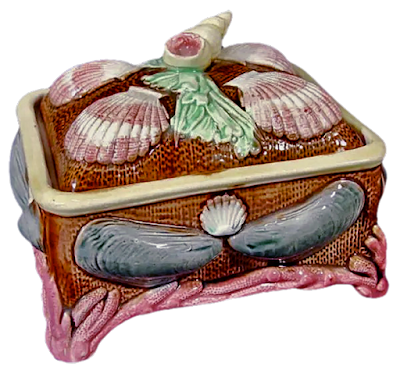George Jones sardine box
Although sardine harvesting has gone on for thousands of years, the history of canned sardines is a relatively recent one. It began in England around 1810 when Englishman Peter Durand developed the first patent for preserving sterilized perishable foods in an enclosed container. In 1822 France, Joseph Collins, aware of the historic preservation of cooked sardines in clay jars in the Breton area of France during the reign of Napoleon, applied methods first developed to preserve sweets, to the fish industry creating the first canned fish. In 1853 the Chancerelle Cannery in Brittany became the first company to take advantage of the plentiful sardine stocks in the offshore waters to create the canned sardine market. Soon their success caught on ‘spawning’ small canneries around fishing ports throughout Europe and the United States.
Sardine tin from the Chancerelle cannery
19th century French sardine ad
Sardine fishing waters around Brittany Humorous French postcard advocating the superior sardines of Marseilles
These canned fish became popular with the military–particularly in America during the Civil War–where there was a need to feed nutritious food to traveling troops. In time, sardine’s popularity caught on everywhere resulting in a market that ultimately created millions of cans of sardines every year.
Civil War era sardine can
Advertisement for Norwegian sardines
French grocery advertising plate featuring sardines
As sardines became the latest food novelty among the middle class, all manner of companies produced specialty products to serve them. No well equipped dining service was complete without special forks with which to serve sardines or special containers in which to highlight the delicacy.
Shiebler silver and gold wash sardine fork
Of course potteries picked up on the popularity of canned sardines and created their own decorative containers to sell to the upscale dining hostess. By the early 1870s sardine boxes became one of the most popular specialty items made by the Staffordshire potteries.
The variety of sardine boxes made by majolica manufacturers created a serving container for every taste. George Jones was a leading innovator in the process.
George Jones Pelican Top Sardine Stand in the aesthetic taste
Shell Sardine by George Jones
Much copied Jones overlapping fish sardine box
George Jones majolica fish sardine box
Very rare George Jones majolica fisherman sardine box
George Jones majolica sardine terrine
Jones duck finial sardine
George Jones majolica basket of fish sardine
George Jones majolica Basket in Boat
Minton, of course, made a sardine box. This one dates from 1867.
Minton majolica sardine box
Wedgwood, whose largest majolica market was in the United States, made sardine boxes late into the Nineteenth Century, long after other large potteries ceased, sometimes with aquatic themes... and sometimes not.
Wedgwood Ocean series sardine box
Wedgwood sardine box matching their Fruit series
Wedgwood Sardinia sardine server
Wedgwood majolica St. Louis sardine box
Wedgwood Mat sardine box
Wedgwood Argenta Early English sardine box
Wedgwood Argenta sardine box
Wedgwood Grosvenor sardine box
Wedgwood Luther sardine box
Wedgwood majolica mottled sardine
Other companies in Great Britain made boxes as well.
Fielding majolica sardine box
Fielding insect and scroll sardine box
Holdcroft majolica sardine box
Holdcroft sardine box with crab finial
Holdcroft sardine box
Forester/Adams & Bromley sardine box
Adams & Bromley majolica pineapple sardine box
Brown-Westhead Moore basketweave sardine box with butterfly finial
Brown-Westhead Moore sardine box
Joseph Roth majolica sardine box
Copeland sleigh sardine box
Victoria Pottery Company sardine box
Samuel Lear Sunflower sardine box
Brownfield pond lily majolica sardine box
Forester majolica fish sardine box
Forester bird finial majolica sardine box
Forester majolica swan finial sardine box
Sardine box attributed to Forester
Alloa Pottery of Scotland produced this sardine box
There are many unattributed sardine boxes. Most are believed to be of British origin.
Possibly by Brownfield or Skey
Attributed to Adams & Bromley
Unusual mermaid finial sardine box
Possibly by Adams & Bromley
Schiller & Sons sardine box
French majolica sardine box
Sarreguemines majolica sardine box
In America, the Etruscan Works of Griffen, Smith & Co. made sardine boxes to take advantage of plentiful sardine catches in American waters. Underplates were sold separately.

An Etruscan Majolica copy of a George Jones sardine design
This sardine was sometimes lined in velvet and given as a gift jewel box
by David Smith's wife
The sardine industry went into decline in Great Britain after the 1880s while the French sardine industry waxed and waned with fish supplies. Sardines though, remained popular worldwide until after WW2. The craze began to diminish by the 1950s. Because of their high Vitamin D content as well as their supply of “good” cholesterol they are still canned and enjoyed today though the market is no longer packed like sardines with devotees.
Sorry about that! I couldn't resist!









































































